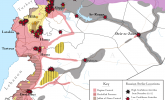 |
 |
Russian Airstrikes in Syria: December 18 - 27, 2015
Dec 27, 2015 - Genevieve Casagrande
Russian airstrikes continue to weaken the position of the Syrian armed opposition ahead of negotiations between pro- and anti-regime forces scheduled for January 25. An alleged Russian airstrike in Eastern Ghouta on December 25 killed leading Salafist rebel commander Zahran Alloush, the commander of prominent Damascus-based group Jaysh al-Islam. Alloush’s death could result in further instability inside rebel-held areas of the capital, threatening the success of a local U.N.-brokered evacuation deal between rebels and the Syrian regime in Southern Damascus as well as the upcoming January 25 negotiations. Jaysh al-Islam was the largest armed opposition group to sign the Riyadh opposition conference outcome document on December 10 and it remains unclear if Jaysh al-Islam will retain its support of the document following Alloush’s death. Russian airstrikes also concentrated across rebel frontlines with ISIS in Northern Aleppo Province, compounding pressure on Aleppo-based rebel factions. The majority of strikes targeted rebel positions from December 22 - 27, although Russian warplanes conducted a limited number of airstrikes in support the regime’s anti-ISIS operations in Homs, Aleppo, and Deir ez-Zour Provinces.
The Russian air campaign continues to target local populations within rebel-held terrain in order to weaken the resolve of the Syrian opposition amidst renewed efforts to bring about a negotiated settlement to the Syrian Civil War. Amnesty International accused Russia of deliberately targeting civilian infrastructure and killing over 200 civilians since the start of its air campaign, asserting that these incidents constitute “violations of international humanitarian law.” The Russian Ministry of Defense (MoD) subsequently denied the allegations.Local activist sources continued to report Russia’s targeting of civilian infrastructure in rebel-held terrain, accusing Russian warplanes of killing as many as 14 in strikes against hospitals in Azaz in the northern countryside of Aleppo on December 25.
The following graphic depicts ISW’s assessment of Russian airstrike locations based on reports from local Syrian activist networks, Syrian state-run media, and statements by Russian and Western officials. This map represents locations targeted by Russia’s air campaign, rather than the number of individual strikes or sorties.
High-Confidence reporting. ISW places high confidence in reports corroborated both by official government statements reported through credible channels and documentation from rebel factions or activist networks on the ground in Syria deemed to be credible.
Low-Confidence reporting. ISW places low confidence in secondary sources that have not been confirmed or sources deemed likely to contain disinformation.
